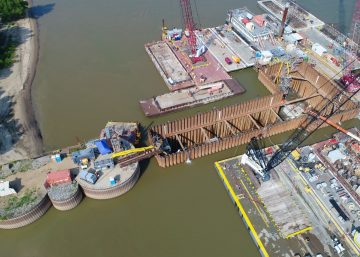A water-filled dam is a essentially a large PVC bag or geotextile tube, which is filled with water. These dams come in a range of sizes to suit varying water depth ranges. The water control depth is typically specified to be a two thirds of the dams fully inflated height. So, say you were trying to withhold water to a 1.0m a water filled dam with a total inflated height of 1.5m would be required. In addition to this and then they’re twice as wide as they are high. For 1.5m total inflated height the water filled dam will be at least 3.0m wide. It will look like a big oval in cross section. This means when the water filled dam is fully inflated it has a hydrostatic mass greater than the hydrostatic pressure generated by the water which it’s being used to withhold.
To prevent the water-filled dam from rolling it needs to stay twice as wide as high, which means they’re either divided into cells, with two internal tubes side by side in a single outer skin holding them together or they have an internal baffle which holds the barrier in an ovoid shape. If it the system had no baffles or cell system it would roll as the hydrostatic load was applied to the side of it. Held in oval shape it won’t roll and the hydrostatic mass internal forces the membrane container tight against the bed, providing friction which prevents sliding. In addition to providing fricative resistance to sliding this also allows the barrier to create a really effective watertight seal with the surface it’s placed on the retained pressure it’ll shrink wrap any structure is placed over.
The downside of the simplicity of the water filled system is that they are essentially just sacks or balloons filled with water. If you get a puncture the whole system fails. Also they struggle to conform to square structures. So if you’ve got a square wall edge your abutting to you’ll usually get a void in the corner, a bit like trying to fit a round peg in a square hole. In addition the simplicity of the design also presents performance limitations. As if the design control depth of the barrier is exceeded the system begins to lose it’s relative anchoring mass. If the water reaches an equivalent height to the inflated height of the water filled dam the whole structure becomes neutrally buoyant and will float or slide. This means it’s not suitable for uses in areas where there is a probability of water level change. Performance on silt and soft bed can also be problematic. The designed water depth for the water filled dam in these conditions will need to be the combined water and silt depth as the silt will act as a liquid. In some instances the water filled dam will work fantastically on silt, displacing it as the dam is inflated and allowing it to contact firm bed. In other instances it fails terribly on silt, sliding on the cohesive, liquid and being shunted into the work area. Part of the reason we stopped using water filled dams was that there was a lack of certainty about their performance. We want to be able to guarantee a solution for our customers and the system didn’t meet the criteria to do so.

